Puruborá
- Self-denomination
- Where they are How many
- RO 243 (Siasi/Sesai, 2014)
- Linguistic family
- Puruborá
Officially contacted by Rondon at the start of the 20th century in the valley of the Guaporé River, the Puruborá were, for decades, considered extinct, mixed with the many waves of rubber tappers who occupied the region which came to be known as Rondonia. But the Puruborá – the “people who transform into jaguars” –, although fragmented and dispersed, were able to survive the century. In 2001 they held their first assembly, which brought together relatives scattered across various parts of the state of Rondonia and elsewhere, and reaffirmed their struggle for the recognition of their traditional territory on the banks of the Manoel Correia River, a struggle which continues to this day, by a people defined as ‘resurgent’ or ‘resistent’ in the Brazilian Amazon.
Name and Population
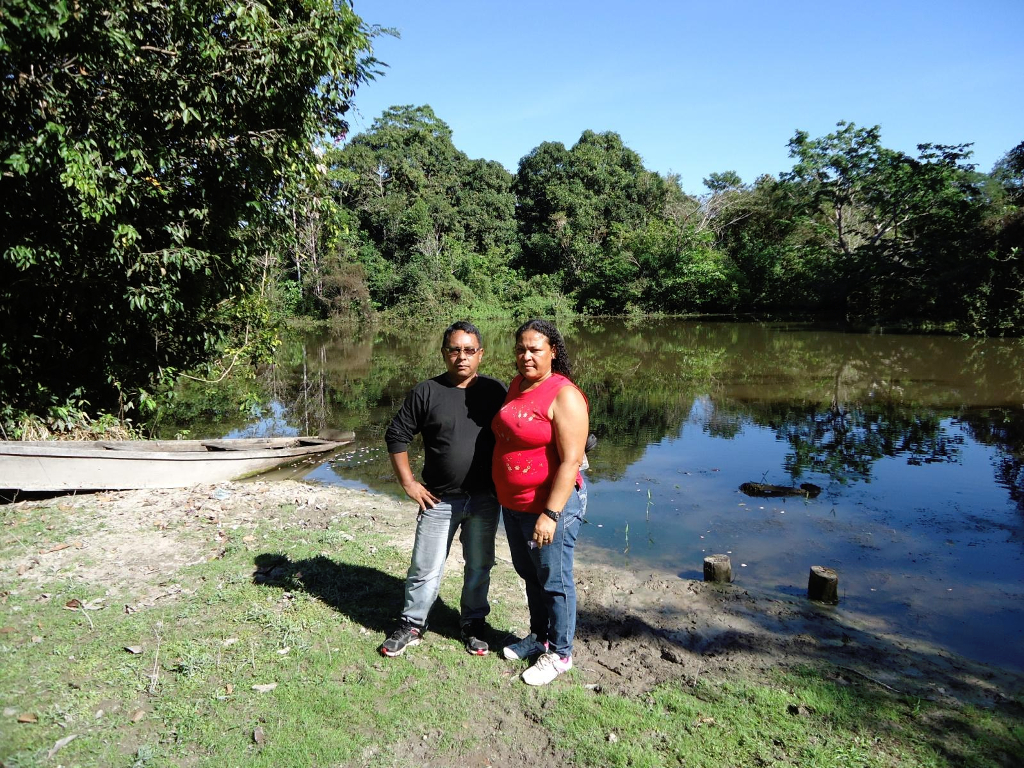
The term Puruborá is a self-designation, which the group translates as ‘one who transforms into a jaguar to heal’ (referring to the old shamen). According to some of the elders, the name ‘Puruborá’ derives from puru, ‘jaguar’ in the Puruborá language, which means ‘people of the jaguars’ or ‘people who become [transform into] jaguars’; the linguistic analysis of the Puruborá language presents the ethnonym as a composition of puru ‘jaguar’ + borá ‘collective’. Alternative spellings (no longer in use) include Borobura (Snethlage), Puru-Borá, Puru-Bora, Borá and Buruborá.
Counting the current Puruborá population has run into difficulties due to the dispersion suffered by the group, since the 1940s through various parts of the state of Rondonia and beyond. Preliminary data collected in the field shows that the Puruborá resident in their only current village (Aperoi) total 40 individuals (2014), divided into 10 residencies spread out through the area between the Caio Espíndola, Manuel Correia and Cabixi Rivers, and federal highway BR-429.
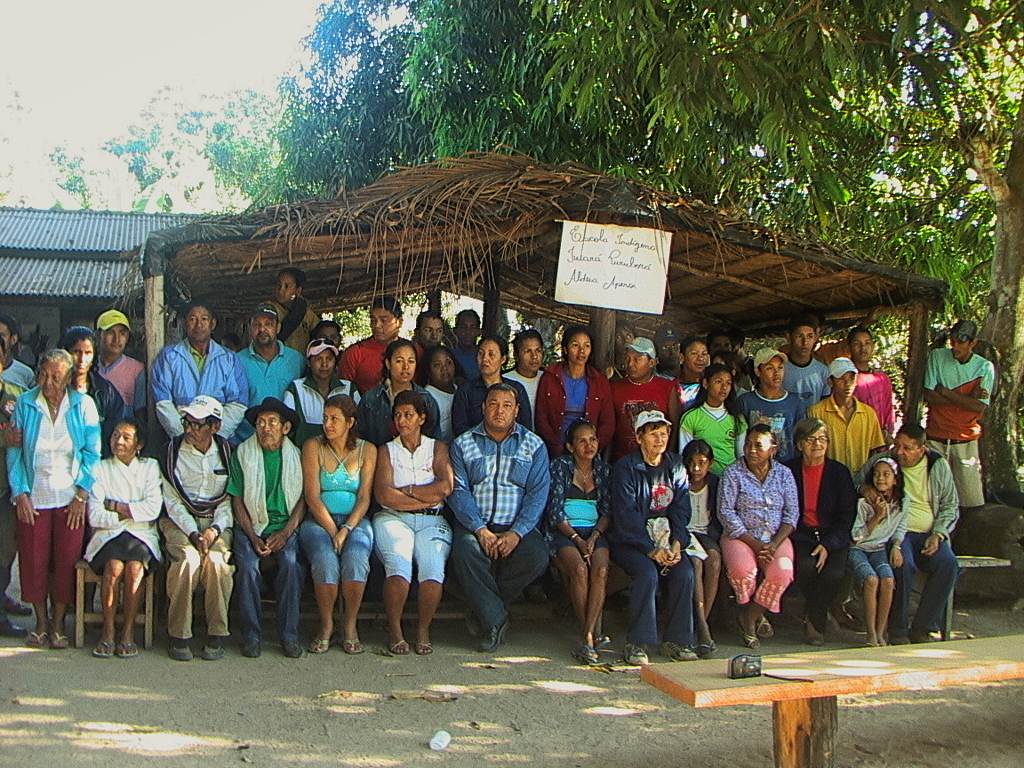
There are other Puruborá families - linked to the Aperoi group through recognised kinship ties which are, where possible, always maintained through visits and meetings - living in several municipalities of Rondonia. The Puruborá themselves mention the existence of between 200 and 1000 people scattered throughout the municipalities of Seringueiras, São Francisco do Guaporé, São Miguel do Guaporé, Alta Floresta do Oeste, Costa Marques, Rolim de Moura, Ji-Paraná, Ariquemes, Porto Velho and Guajará-Mirim (this last city has a significant Puruborá population, possibly of around 200 people, including two of the oldest individuals of this people, seu Eliézer and seu Nilo).
Ruth Henrique da Silva’s report (2008) states that the Puruborá are “around 300 people”. CIMI data on Rondonia accounts for a population of 220 individuals in Puruborá in 2015. The COMIN (Indigenous Peoples Mission Council, a body linked to the The Evangelical Church of the Lutheran Confession in Brazil - IECLB) speaks of 400 Puruborá living scattered throughout the state of Rondonia.
The only available historical information regarding the Puruborá population seems to be from Olympio da Fonseca Filho, who was at the headwaters of the São Miguel River in 1924 and counted about 50 people.
Language

The Puruborá language is the only known representative of the Puruborá language family of the Tupi tree. It is little known scientifically and is a critical example of the risk faced by most indigenous languages in Brazil. It is among the Tupi tree languages which are most at risk of disappearing in the near future, as it is no longer used as a vehicle of communication nor taught to children for at least three generations. The Puruborá language no longer has any fluent speakers, only very few semi-speakers.
By 2015 there were only two elder Puruborá semi-speakers, both quite debilitated by age and health problems. However, the younger generations, aware of the possibility of the irreversible loss of their linguistic and cultural heritage, are interested in possible actions for the revitalisation of the language.
Up until 2001, the only sources of information on the Puruborá language were old lists of words:
- Two missionaries are reported to have visited the Puruborá in the 1950s and collected linguistic and cultural material, although this material has never been found.
- The most extensive list of words had been collected by Theodore Koch-Grünberg, in 1932, with a Puruborá adolescent, and contains 328 lexical entries.
- The second list is part of the standard vocabulary of the National Museum, containing only 49 words, and was collected by William Bontkes in 1968, with a 65-year-old Puruborá speaker called Tereza, in Limoeiro, on the São Miguel River.
- The third is a list of 130 lexical items in Puruborá, recorded in 1989 by the linguist Denny Moore of the Emilio Goeldi Museum of Pará, with three Puruborá survivors who lived in the municipality of Guajará-Mirim (RO). Copies of these tapes and their respective transcriptions can be found in the Goeldi Museum's Indigenous Language Collection. In 1989, on the occasion of this recording, the three Puruborá said that after decades without speaking the language, they were no longer fluent in Puruborá.
- A list of words (202 lexical items) collected by linguist Ruth Monserrat in October 2001, during the Meeting of Puruborá Relatives, was published in 2005 with information on the group and its language.
Further Reading
- The Puruborá Language Documentation Project (Portuguese)
- Characteristics of the Puruborá Language (Portuguese)
A project for the Documentation of the Puruborá Language, coordinated by Ana Vilacy Galucio from the Emílio Goeldi Museum of Pará, was developed in the period 2001 - 2007, with the purpose of contributing to the safeguarding and appreciation of the Puruborá language. The collected material also includes phrases in the Puruborá language. The possibility of documenting this type of material was a huge step for the project, as no other previous lists contained information of this nature. The material collected by the Puruborá Language Documentation Project makes up the largest available archive on the Puruborá language and is held at the permanent collection of the Emilio Goeldi Museum's Indigenous Language Documentation Center.
Collected data on the Puruborá language allowed for a comparison with other Tupi languages, from which a greater similarity between the Puruborá and Karo languages became evident. In a preliminary study, Galucio and Gabas Jr. proposed that the Ramarama families (Karo language) and Puruborá (Puruborá language) are closer to each other than to other Tupi families, indicating the forming of a subgroup (or subgrouping) within the Tupi tree: the Puruborá-Raramara family.
Location and Territory
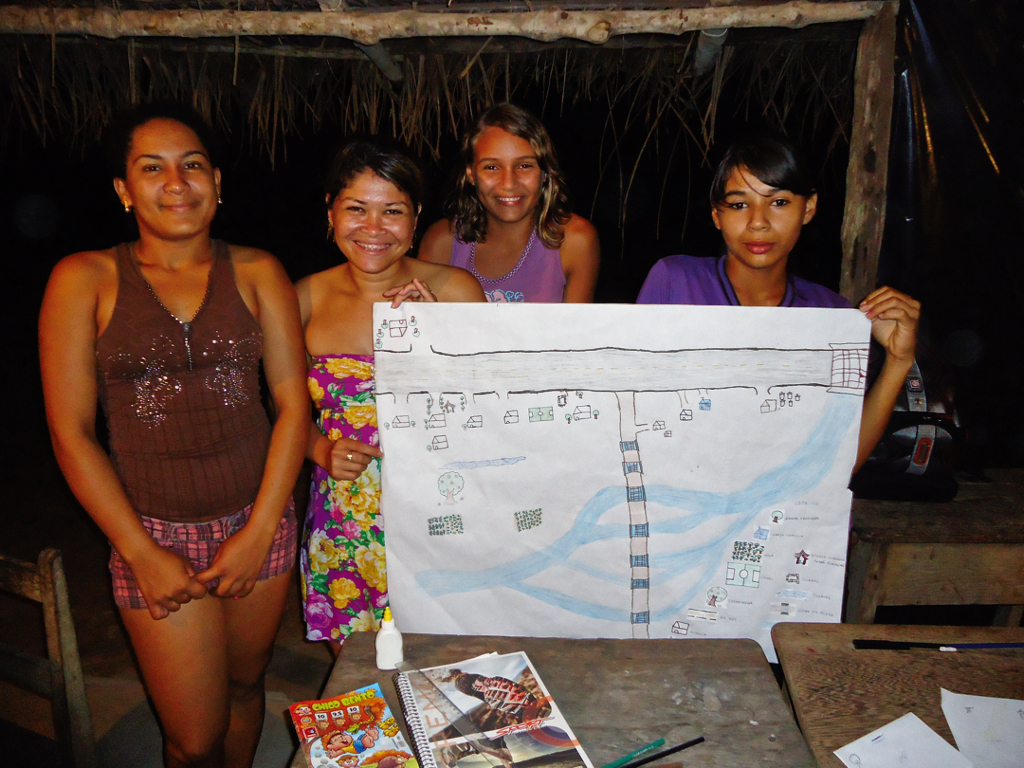
The only current Puruborá village, Aperoi village, is located along the BR-429 highway, between it and the Manuel Correia river. The village is around 32km away from Seringueiras, towards Costa Marques, and its territory stretches between the municipalities of Seringueiras and São Francisco do Guaporé, east of the state of Rondonia.
The village is bordered, to the west and north, by the Manuel Correia River, near its confluence with the Caio Espíndola River, which forms the São Francisco River, an affluent of the São Miguel River, which in turn flows into the Guaporé, to the west.
There are still many Puruborá families living in other municipalities of Rondonia (São Francisco do Guaporé, São Miguel do Guaporé, Alta Floresta do Oeste, Costa Marques, Rolim de Moura, Ji-Paraná, Porto Velho and, especially, Guajará-Mirim).
The Puruborá have not yet had their indigenous land recognised, demarcated and homologated. Although scattered in several cities of Rondonia, the group recognises the old site of D. Emília, where the Aperoi village stands today, as the centre of reference of their current territory. It should be noted that many of the lands which make up the village have been acquired by the families, and are therefore private property. Preliminary work for the identification of the Puruborá indigenous land points to the region between the rivers Caio Espíndola (to the west) and Cabixi (to the east), and between the BR-429 (to the south) and the Uru-Eu-Wau-Wau Indigenous Land (to the north) as territory traditionally occupied by the Puruborá, and recognised by them not only as their main area of population concentration since the beginning of the 20th century (on the banks of the Manuel Correia River, which served as an axis to guide most of the group’s movements throughout the previous century), but also as an area for wandering and the exploitation of resources, especially Brazil nuts. The region was previously covered with extensive Brazil nut groves, many destroyed with the area’s occupation by cattle farms and soy plantations. The oldest Puruborá remember an intense circulation between the different points of rubber extraction along the Manuel Correia River, from its uppermost section, in the north, down to its confluence with the Caio Espíndola, in the south.
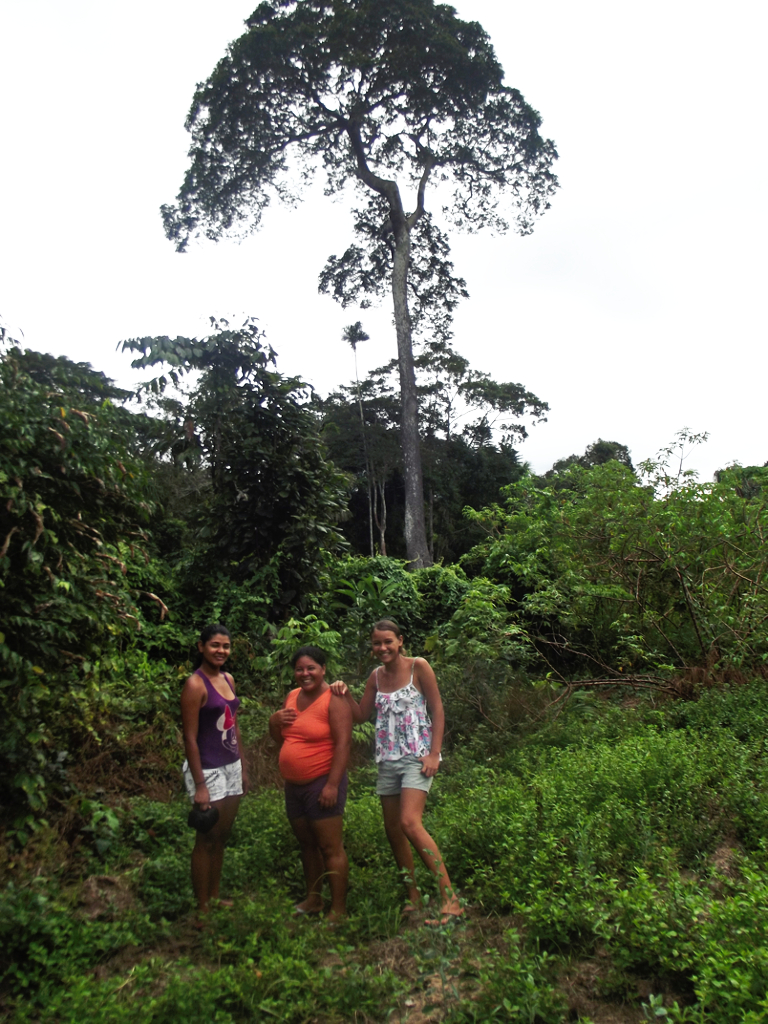
The former large areas of Brazil nut trees are also present in Puruborá memory, as well as the use they made of the nuts. The Puruborá are proud that, in the past, the Brazil nut trees provided the basis of their diets; the Brazil nut trees elicit memories from several Puruborá elders; they recall memories of a happy past, experiences and moments of relative peace and abundance. The oil and milk from the nut were widely used for cooking and frying food. From the times in which they lived in the Cigana, the elders taught the young to extract oil from the nut, the patuá and the açaí. The oil from the Brazil nut was also used for medicinal purposes: oil would be applied to the head and middle of the spine to lower a fever. Several more elaborate recipes feature the Brazil nut as main ingredient.
Among the many foods of plant origin in the village and surroundings, the Brazil nut trees are the most prominent, because they hold such a strong reference to the past. The nut trees were used as a point of reference and location by the Puruborá. These enormous trees were once exploited in the upper courses of the rivers Manuel Correia and Cabixi; however, these lands were acquired by farmers and the forests (including the prized Brazil nut trees) were cleared for pasture formation, which the Puruborá regarded, and still regard, with great sadness.
It should be noted that a large part of the traditional territory of the Puruborá (the headwaters of the Manuel Correia River) was included within the borders of the Uru-Eu-Wau-Wau Indigenous Land (including the place known as Cigana, which is of great historical importance for the group). The Puruborá have agreed to give up the areas already demarcated by FUNAI, especially regarding their Uru-Eu-Wau-Wau and Amondawa ‘relatives’, but are consistent in affirming their presence and economic exploitation of the surrounding areas located between the southern border of the Uru-Eu-Wau-Wau territory and the BR-429 route, with the Cabixi River - where in the past they would usually fish, given its apt conditions - as its furthest western limit.
Indeed, the available historic data, as well as the narratives collected among the Puruborá, warrant the claim that they effectively have occupied the region between the rivers Caio Espíndola, Manuel Correia and Cabixi (all of which form the São Miguel River, itself a tributary of the Guaporé River) since time immemorial, with brief periods of forced removal from the region.
In this sense, what the Puruborá today call ‘their lands’ corresponds to a territory slightly larger than that demarcated by Rondon in the surroundings of the former Posto Três de Maio. This is evident from the historical trajectory of the group since the first contacts at the start of the 20th century: they were initially drawn by the post (Posto); after 1949 they spread themselves through neighbouring regions, returning to occupy the surroundings - now a region known as ‘Colônia’ - for various periods, extensively and intensively using the region's resources of the rivers forming the São Miguel, until their complete expulsion in 1994, when they finally settled on the sides of the highway, where they remain until today, continuing to exploit the lands between the BR-429 and the Manuel Correia River - which corresponds to the territory of the Aperoi village - and some adjacent areas in seeking certain resources, such as hunting, fishing, farmlands and raw materials for crafts.
It should be noted that the historic region, currently inhabited and exploited by the Puruborá, is environmentally quite degraded due to its occupation by large cattle ranches. The only preserved areas of forest are almost entirely concentrated on the banks of rivers and streams and within the confines of the Uru-Eu-Wau-Wau Indigenous Land; and even there, the farms, in many places, have taken deforestation right up to the border of the indigenous land. Recent studies show that the ‘soy frontier’ is quickly encroaching upon the Seringueiras region, with many ranchers leaving the area and selling their properties for grain cultivation. The relationship of the Puruborá with the local farmers is quite conflicted. Since they began claiming their lands they have been constantly threatened, especially in nearby cities, and many have started to deny them work in the region’s rural properties.
Contact History
The first references to the Puruborá date from the early 20th century. Darcy Ribeiro still considered them ‘isolados’ (uncontacted) in 1900. According to Puruborá elders, Marshal Candido Rondon contacted the group in 1912, in the surroundings of the São Miguel River. Other elders claim that Rondon had already found them in 1909, in the surroundings of the rivers São Miguel and its affluent Manuel Correia.
The Puruborá claim that they originate from the region of the Branco River, where they lived in contact with the Makurap, Aruá and Tupari, but, due to disagreements, migrated to the valley of the São Miguel River, still in remote times; Emil-Heirich Snethlage, travelling through the valley of the Guaporé River in 1934, confirmed the claim that the Puruborá formerly lived on the Branco River, and later moved to the São Miguel River.
According to Mr. Celestino (who lived in Porto Murtinho), before contact with Rondon, the Puruborá lived in a place they called ‘Maloquinha’, together with the Cabixi indians, on the right bank of the Manuel Correia River; later, they occupied a single village on the Paulo Velho stream, an affluent of the Manuel Correia, quite close to Colônia, which they then moved to after the nucleation encouraged by Rondon. The group known as the Cabixi would have quickly been extinguished, although there have been reports, in Rondonia, of the existence of some survivors.
The Puruborá have their own version of Rondon’s arrival on their territory, a narrative which is not without a hint of criticism of the work of the Commission he directed: according to them, when exploring the region where the Puruborá were located, one of Rondon’s dogs - which according to the Puruborá, the Marshall overly cherished, even preferring his canine companions to the humans under his orders - disappeared in the forest. Concerned, Rondon ordered his men to set off fireworks in an attempt to make the dog follow the noise back to the expedition. The deafening and strange noise in the forest attracted not only the runaway dog but also the Puruborá, who, intrigued by the unusual noise, approached them with curiosity and established their first friendly contact with the non-indians.

According to a letter from Marshall Rondon dated 23rd June 1921 (which can be found in the SPI/Museu do Índio archives), an area of land for use by the indians of the São Miguel River (among them the Puruborá) was delimited on the right bank of the Manuel Correia River, below the mouth of the Cigana stream (a place which received this name due to the abundance of a bird popularly known as ‘cigana’, Opisthocomus hoazin). The area spanned a radius of two leagues (about 67,600 hectares), centred on the Três de Maio Indigenous Post (other informants have stated that the name of the post was Dois de Maio), as named by Rondon at the time of its foundation in 1919, at which time the boundaries were set, having been confirmed by Benjamin Rondon, the marshall’s son, in 1925. Rondon left the Três/Dois de Maio post in the care of Mr. José Félix Alves do Nascimento, “who by my order will settle definitively in this place [with] broad powers to exercise his function”, in the words of the then Brigadier General Cândido Mariano da Silva Rondon. It was probably in these conditions that Olympio da Fonseca Filho, an epidemiologist linked to the Manguinhos School, must have found, in 1924, the close to 50 Puruborá he reported as “living at the headwaters of the São Miguel River”; Fonseca left a brief account of an endemic dermatosis among the Puruborá (called ‘chimberê’ in the indigenous language) which he observed in loco, taking what appears to be the earliest known pictures of Puruborá individuals: the face of a young man, a woman’s bare torso and a man’s back, all visibly affected by the skin disease. Fonseca Filho, in his study on the ‘chimberê’, reports that the Puruborá had been contacted by “people from the National Indian Protection Service (Serviço Nacional [sic] de Proteção aos Índios)” in 1921, on the upper São Miguel River; the parasitologist also reports that, in 1924, the Puruborá he met constituted “a populational group completely segregated from contacts [sic] with representatives of our civilisation”.
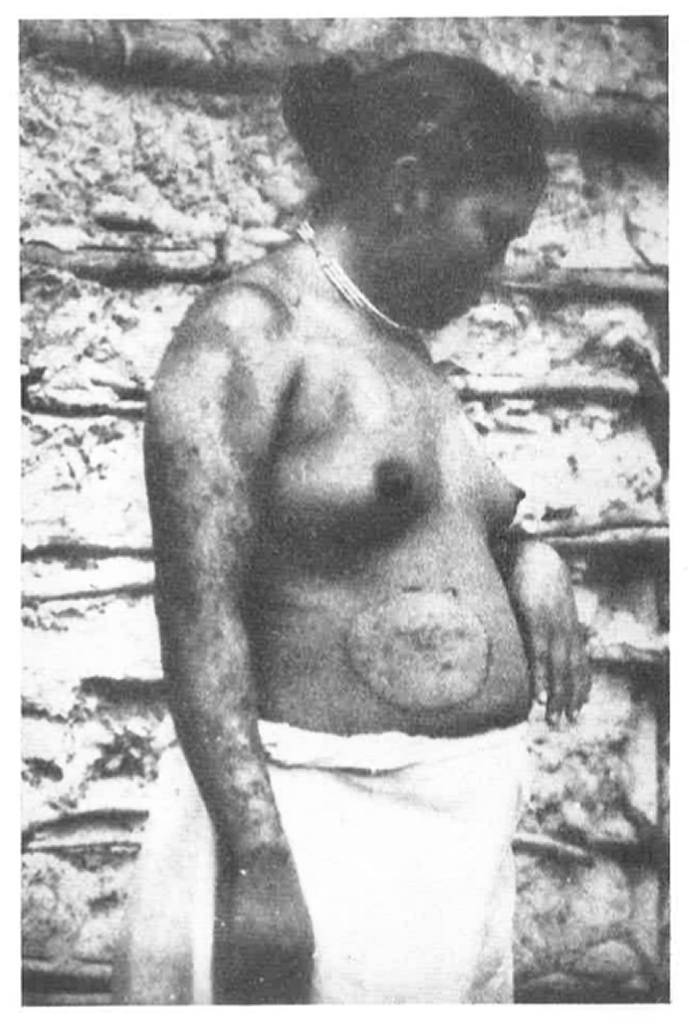
At first, according to the elder Puruborá, the post would house around 600 people, who would have been reduced to 150 through epidemics (flu, measles, chicken pox and mumps) which hit the region soon after the first contacts. Furthermore, the Três de Maio Post was inhabited, in addition to the Puruborá, by the Gavião indians, who were of the same region, later receiving the Cabixi and Migueleno indians who also lived in the valley of the Manuel Correia River. Other accounts report that José Felix used the Puruborá, who had been contacted first, as helpers to establish peaceful contact with neighbouring peoples – Migueleno, Cabixi, Makurap and Tupari - and then bring them to the Três de Maio Post, where they all immediately thereafter would be made to work extracting rubber.
The mechanism adopted by José Félix - who is said to have learnt the indigenous language and married a Puruborá woman - for the administration of the Post seems to have been, according to contemporary Puruborá narratives, decisive for the social dismantling of this people and the rapid extinction of their language. José Félix acted like a rubber plantation boss, forcing the indians to cut rubber and collect Brazil nuts in exchange for goods. He also instituted the practice of giving an indigenous woman in marriage as a prize to the men who excelled at latex production. According to reports, newly arrived migrants would earn a ‘placement’ from José Félix if they accepted to marry indigenous women. As such, practically all Puruborá women from 1919 to 1949 (from the Post’s foundation until the death of José Félix) were forcibly married to rubber tappers (including the elder D. Emília) which caused the disintegration of the group which hitherto lived in the surroundings of the Posto Três de Maio. Furthermore, the multiethnic families which formed - Puruborá mother and seringueiro father (mostly from Amazonas, Ceará and Acre) - were forbidden to speak the indigenous language, which seems to have lead to the almost complete extinction of Puruborá in a single generation. Much of the indigenous practices and knowledge ceased to be passed on, including the language, rituals, celebrations and shamanism.
We have more information on the Puruborá for the period between 1920 and 1940. They were then located in the valley of the São Miguel River and its affluent, the Manuel Correia River. Curt Nimuendajú, in his famous Ethno-historical Map (1981), locates the Puruborá at the upper São Miguel River; however, he does not provide a date for this location. He credits this to information from Emil Snethlage (probably from personal communication) and his book, Atiko-Y, and to a publication by Theodor Koch-Grümberg (1932) which contains one of the lists of words which have made possible the present day study of the Puruborá language. Koch-Grümberg himself claims to have collected the list of entries in August 1924, in the city of Manaus, with a Puruborá boy named Atekáte of around 10-12 years of age, who had a small hole in his upper lip and ‘came from the Manuel Corrêa River, a tributary of the Guaporé’ (Er stammte vom Rio Manuel Corrêa, Nebenfluss des Rio Guaporé).
In June 1934 the Puruborá (then known as the Purus-Borás) were visited, in the place known as ‘Colônia’, by the bishop of Guajará-Mirim, Dom François Xavier Rey. The bishop, visiting the vast and inhospitable regions of the valley of Guaporé in the 30s, recorded his stay with them:
The Purus-Boras Indians - São Miguel River
11/06/1934
We reached José Felix’s Colônia at two in the afternoon, after a long journey and two starlit nights spent in a pascana [forest camp]. Upon our arrival, the Purus Boras indians, whom José commands and whom he ‘civilised’, emerge to greet us. Well-dressed, well-mannered, healthy, understanding and saying some Portuguese words, respectful of family, hardworking and with some notion of the ‘Heavenly Father’ (Papai do Céu’), imitating the gestures and attitudes of Catholics, of jovial character, peaceful: such are the Purus Boras indians. They no longer use bows and arrows, only firearms. At night, prayers. All sing the Hail Mary and ‘Blessed Be’. Their eyes shine when I speak of the ‘Heavenly Father’."
12/06/1934
Mass. Rosary. Chants. Later, Heliodoro de Albuquerque came, student Olga’s father. He is a caucheiro. He lives in a shack six hours’ journey downstream from José Félix, on the Manoel Corrêa River. I copy a list of words from the Purus-Boras indians’ dialect. 19 baptisms. Prayers and confessions.”
In 1949, with the death of José Félix do Nascimento, the Indian Protection Service (SPI) extinguished the Post and refused to send a new appointee alleging that there were no longer any indians there and that the ‘people were already mixed race (mestiçado)’ or that the indians there were ‘mixed race’ (‘mestiços’) or ‘civilised’. At this time, most families left their region of origin, moving to settle in Limoeiro (a rubber plantation at the time), on the São Miguel River, to the south (today the interior of the Guaporé Biological Reserve), and began working for local rubber tappers. In 1982, the Puruborá who lived in the village of Limoeiro were expelled after the creation of the Guaporé Biological Reserve (REBIO). Mauro Leonel points out that “IBAMA expelled them, unnecessarily and without compensation, because they were within the limits of the Guaporé Biological Reserve’. Only the families of Paulo Aporete Filho and Dona Emília remained at the site of the former SPI Post (which they recognise as their traditional territory) for longer. Sr. Paulo remained there until 1983 (others claim 1984 or 85), when he left the region due to health problems.
Dona Emília's family returned in 1955 (after many comings and goings) to the place known as Cigana, on the Manuel Correia River, and from this time the Puruborá children of Dona Emília (and others in the age range of 40-50) recall a number of settlements they lived in along the river before their definitive expulsion in 1994. The Puruborá name at least 25 of these places of habitation and exploitation of rubber, nuts and poaia along the river, from its confluence with Caio Espíndola River, to the south, (Porto Olga settlement), to the Vai-quem-quer settlement, on the upper Manuel Correia; among these were the settlements called Colônia (from where the Posto Três de Maio operated), Cigana (which was occupied by the Puruborá until their expulsion in 1994) and Bicentenário, where the Bicentenário Port was located, which served the commercial activity (the trading of rubber and Brazil nuts) of the rubber plantation managed by José Felix do Nascimento.
However, some families resisted the impact of the social and ethnic dismantling brought about by the Post, and were (and still are) essential to the reorganisation of the Puruborá as an ethnically differentiated collectivity in the eyes of the state in recent years. (It should be noted that the Puruborá have always identified as a singular collectivity in relation to other indigenous and non-indigenous groups in the region; they only ceased to be recognised as such, at some point, by the state.) One of the most important of these ‘nuclei’, constituted around Dona Emília Puruborá (deceased in 2013) and which gave rise to the current Aperoi village, condenses the history of the Puruborá before their ‘extinction’ as a distinct indian ethnicity, during the period of invisibility and after their ethnic reorganisation. It is this ‘nuclei’ which, today, lends substance and form to the Puruborá as a recognised indigenous people at the local, state and national level.
In 1957, Darcy Ribeiro located between 50 and 100 Puruborá living at the headwaters of the São Miguel River, characterising them as ‘an indigenous group with intermittent contact’ with national society. Ribeiro is probably referring, based on SPI documents, to Dona Emília’s group living on the Manuel Correia River, which forms the São Miguel.
With the demarcation of the Uru-Eu-Uau-Uau Indigenous Land in 1994, Dona Emília’s family was expelled from Cigana, as a large part of it - including the mouth of the Cigana stream (or igarapé), a place of great importance for the Puruborá - was included within the indigenous land (over 50% of the former Posto Três de Maio area). FUNAI technicians did not see indians there, only a group of rubber tappers in close proximity to areas inhabited by the Uru-Eu-Uau-Uau and uncontacted groups which still today wander through the Indigenous Land. The many years of displacements in the region, and the many interethnic marriages, caused the Puruborá to become, in a sense, ‘invisible’ to FUNAI agents, which does not mean, of course, that the group did not identify as Puruborá; only that the diacritical signs normally used by the Brazilian state to determine who is indigenous were absent, at that time, from the instruments of identification used by the indigenist agency.
From Cigana, the Puruborá descended the Manuel Correia River, settling next to the BR-429, near to the point where the rivers Manuel Correia and Caio Espíndola meet to form the São Francisco River, itself an affluent of the São Miguel, where they remain until the present day, called the Aperoi village. The lands were acquired by purchase by the family of D. Emília and inherited by her relatives. Almost all the Puruborá who live in the village are descended from Dona Emília.
During the entire period extending from Darcy Ribeiro’s accounts up until the start of the 2000s, references to the Puruborá people practically disappear, to the point of being considered extinct, as well as their language. Until the start of the 21st century, when the first contemporary political movements of the Puruborá began, official records made no reference to the group within the framework of the country’s current indigenous peoples, nor the Puruborá language among spoken indigenous languages in the state of Rondonia.
A milestone in the contemporary revitalisation of the Puruborá indigenous peoples occurred between the 16th and 18th of October 2001, when the Meeting of Puruborá Relatives was held, with backing from the regional Indigenist Missionary Council (CIMI), bringing together around 40 people at Dona Emília’s site, which is the location of the Aperoi village today. On the occasion, today named ‘the 1st Assembly of the Puruborá People’, the Puruborá began their struggle for their rights, producing a document “claiming from the competent authorities an area in the original Puruborá territory” according to Gilles de Catheu of the Guajará-Mirim CIMI. The Puruborá have been meeting annually at the same location, even after Dona Emília’s death in 2013. The meetings continue to be organised by her daughter, Hozana Puruborá, one of the group’s leading figures, and have been bringing together more and more relatives from different parts of the state of Rondonia. At all assemblies the Puruborá produce documents reaffirming their territorial claims and specific rights as yet another indigenous people of Rondonia.
The Aperoi Village

The Aperoi village, the only village of the Puruborá people in the present day, is located next to the BR-429 highway, between the Rondonian municipalities of Seringueiras and São Francisco do Guaporé. It appears to be a typical rural neighbourhood, forming around the site belonging to the late Dona Emília, a kind of matriarch of this indigenous people whose lands were purchased after the group’s expulsion from the headwaters of the Manuel Correia River with the demarcation of the boundaries of the Uru-Eu-Wau-Wau Indigenous Land in 1994 (the site has about 59 ha. and is legally guaranteed by INCRA title). In effect, Dona Emília’s former house continues to function as a kind of gateway to the village, consisting of a set of houses - mostly made of wood - scattered over an area bordered to the west and north by the Manuel Correia River, close to its confluence with the Caio Espíndola River, which forms the São Francisco River (the two rivers meet right under one of the BR-429 bridges). The village itself was reportedly founded in 2004, during the fourth assembly of the Puruborá people (13th - 15th July of that year). However, this territory has been travelled and explored by the Puruborá since time immemorial, and has been inhabited continuously by Dona Emilia's family (along with other relatives) since 1994, when the lands of the region were acquired by purchase.
The entrance to the site is bordered by leafy mango trees, which lead to Dona Emília’s old house, today occupied by a young Puruborá couple and, further down, to the rich backyard and home of the cacique Hozana Puruborá, the main current Puruborá leader. The complex surrounding Hozana’s house, Dona Emília’s former residence and the shed where assemblies, gatherings and meetings take place (and where formerly an indigenous school once functioned), seems to operate as a sort of symbolic centre for the social, ritual and political life of the Puruborá, as well as a preferred setting for the development of their struggles around ethnic recognition and the identification and demarcation of their traditionally occupied lands. All other family residences are arranged around this centre, located at a certain distance from each other: each house is home to a family and is surrounded by both gardens (usually at the rear) as well as yards, where an enormous variety of edible, medicinal, used for crafts or simply ornamental plant species (which are much appreciated by Puruborá women) are cultivated with great care and attention.
The yards are the most prominent spaces in the village, as a result of the rarefaction of the surrounding forest and the sparse cultivation of fields. Thus the women of the village devote special care to them. The yard is a sort of repository for the large variety of existing plants; although they ‘circulate’ through various places, it is in the yards that they settle and find shelter, and where seedlings and seeds are exchanged. The women are responsible for the care and cultivation of the plants in the yards, which are swept and hoed regularly. The men sometimes help the women to clean the yards, but it is a predominantly feminine task.
The yards of the village are almost always in bloom, and the large diversity of plants reflects the desire to always add new species. Fruit plants are indispensable to the Puruborá diet, to the extent that the yards are made up of several fruit trees. According to the Puruborá, in Cigana there was an immense diversity of plants and, regarding that variety, Aperoi mirrors the region. “Everything that is here, there was in Cigana”, say the Puruborá. The plants are part of a memory and reconstitution of a space of the past. The dream of demarcation of Puruborá lands is linked to the cultivation of more and more plants. All Puruborá residents of the Aperoi village recognise close kinship ties among themselves, although there are several individuals married to non-indians living in the region. There is an intense communitarian sociability, of frequent visits, festive meals, exchanges of foods (especially fruits) and plants and, at certain times, political activities, with annual assemblies of the Puruborá people being held annually in the village since 2001.
The Ywará Puruborá Indigenous State Primary School operated, since its foundation in 2005, in a straw-covered wooden building in front of Dona Emília’s former residence. In 2014, a new and better equipped wooden building, composed of a classroom, kitchen, pantry and lavatory, was built near the old school, where classes take place today under the responsibility of three indigenous teachers.
Material Culture
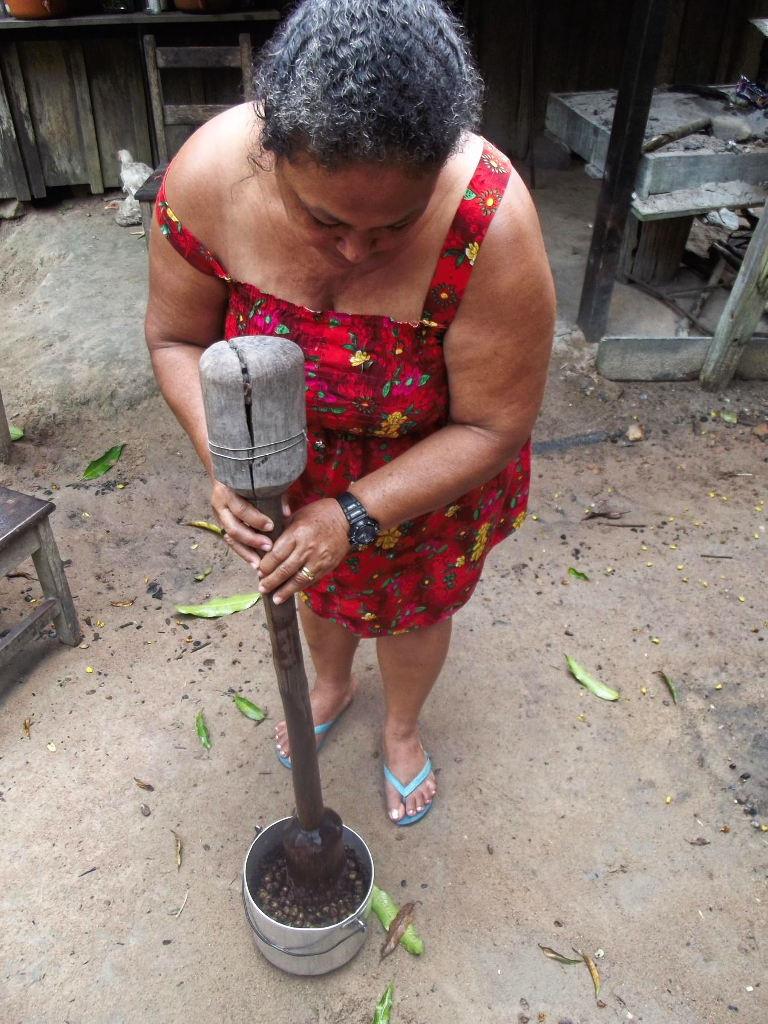
Nowadays, the material culture of the Puruborá differs little from that in production and use by the surrounding regional population, with the exception of handicraft made by some women, especially the cacique Hozana Puruborá, which makes abundant use of local raw materials (wild bird feathers, seeds, straw). The making of 'maricos' (tucumã fiber bags), cotton and tucumã nets, necklaces, earrings and rings, place Puruborá handicraft within the set of handicraft traditions of indigenous peoples of the Guaporé valley (a set of societies which Denise Maldi Meireles grouped under the label ‘Marico Cultural Complex'). Many of the houses in the Aperoi village are decorated with patchwork rugs of varying colours, shapes and sizes, made by women.
It is common to find old indigenous artifacts scattered throughout the village territory. When clearing part of their fields to plant foods, the Puruborá sometimes find ceramic shards, arrow heads and pieces of so-called ‘indian bread’, made from manioc flour dough and formerly buried in the ground for consumption by groups on the move, later forgotten. Apparently the Puruborá were great ceramists, although unfortunately archaeology on Rondonian lands is still almost totally absent and there are no studies in the region.
Productive Activity
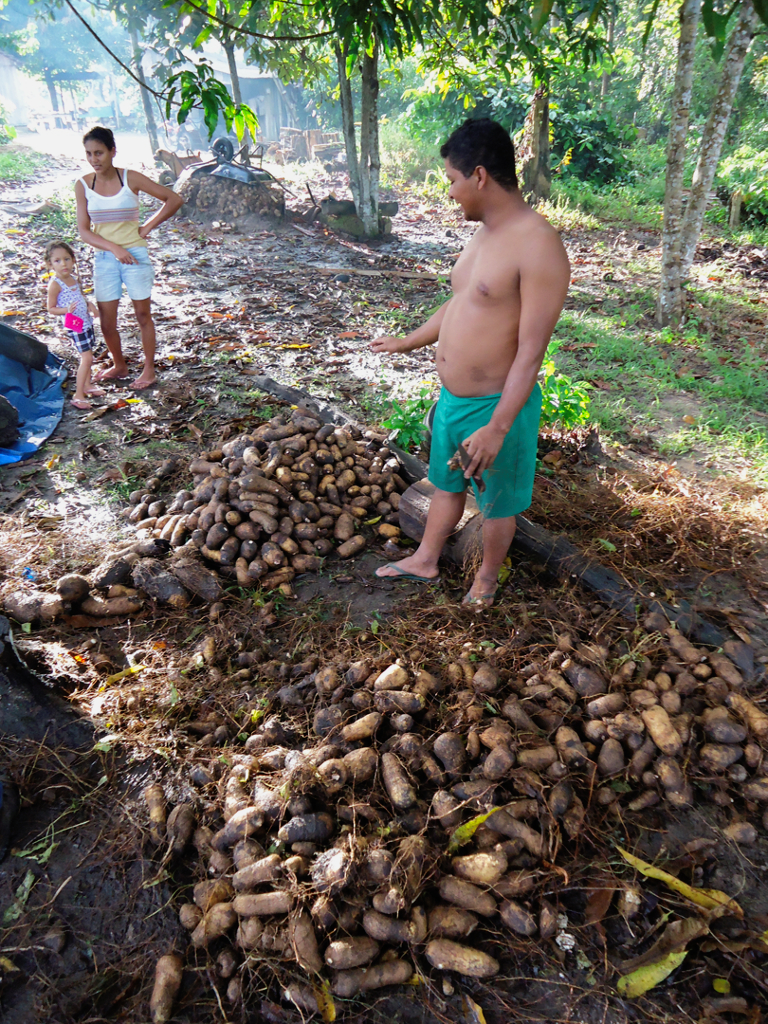
Most of the Puruborá residences in the Aperoi village cultivate crops more or less extensively, producing subsistence crops (macaxeira, beans, corn, pumpkin, sweet potatoes, coffee). Some families commercially plant yams (the Seringueiras region is a large producer), from which they make an additional income; many complain, however, that the lands which they occupy today are not good for planting, arguing that farmers occupied the best agricultural land in the region. Some residences also have small cattle ranches. Almost all families in the village sell milk, which is stored in their own refrigeration containers located in a family’s house; the milk is delivered to this house in the morning and bought by a dairy truck throughout the day. Reference should be made to the enormous wealth of plants which the Puruborá grow around their homes, including many species of fruit, spices and medicinal herbs, as well as ornamental and other plants for making handicrafts. Hunting is rarely practiced anymore, mainly due to the drastic reduction of local forest areas; but some animals - mainly armadillos, agoutis, pacas and bush hogs - can still be found. The consumption of game meat in the village is not the main source of protein of the Puruborá and is only complementary to their diet. Fishing also yields little, but improves in the summer (dry) season.
Harvest consists of certain fruits and raw materials for making handicrafts: in this respect, the Puruborá greatly resent the felling or death of most of the Brazil nut trees which existed on their territory, as they greatly appreciated the nuts (their ‘milk’ especially, which was used in many culinary recipes) and used to travel extensively through the territory in search of the large Brazil nut trees in the Manuel Correia valley. However, despite the village’s productive activities, many Puruborá have jobs in the city or work for regional farmers.
Social and Political Organisation
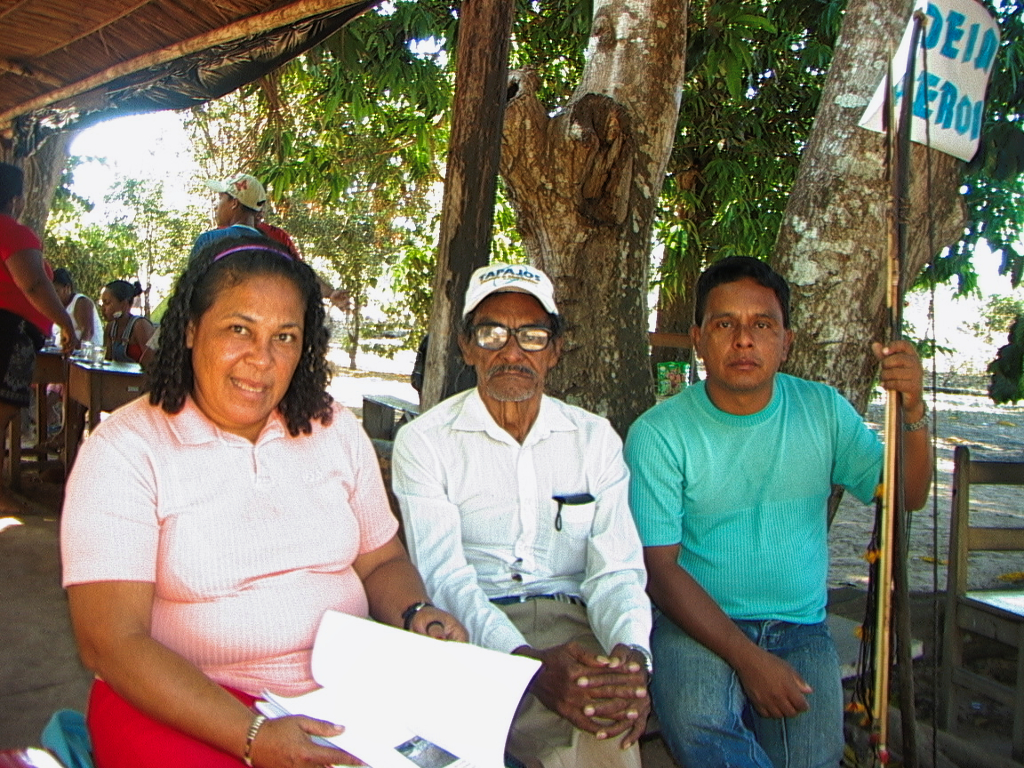
Little can be said of the social and political organisation of the Puruborá, in the absence of more in-depth anthropological studies of this people. Currently, at first sight the Puruborá community living in the Aperoi village is little different, as mentioned previously, to the surrounding rural populations, including with respect to kinship. Many Puruborá are even married to regional non-indians, but all Puruborá recognise the kinship between each other, genealogically traced back to an elder (usually a woman) who would have lived in the time of José Félix. Of all the currently living Puruborá, only six are considered truly elders, having memories of past times and knowledge of disappeared native practices and some of the indigenous language (words and a few phrases). Two of them live in Costa Marques (Sr. Paulo Aporete and D. Adélia), two in Porto Murtinho (D. Marta and Sr. Celestino), and two in Guajará-Mirim (Sr. Nilo and Sr. Eliézer).
Two institutions, however, seem to point to a uniqueness in the group’s social and political organisation. The first refers to the multiple relationships of commensality and reciprocity found in Aperoi. Products from Puruborá fields and yards enter networks of reciprocity, food sharing and processes of mutual identification. The variety and quality of the cultivated products depend on their knowledge and abilities as growers, as well as their capacity to obtain new species for cultivation. The success of crops lies, then, in the diversity of species, but also depends on the networks of social relations in which people are situated: cultivating cassava or maize means cultivating their relationships. In this sense, Puruborá women sustain the bodies of their ‘closest’ relatives, but the reciprocal networks can spread, connecting homes that are sometimes donors, sometimes recipients of food. Since all Puruborá in the village are related, in this case, the ‘closest’ relatives are parents, sons and daughters, and siblings. Within these categories of kinship, there is freedom to pick fruit and other foods from yards and fields without worry or restriction. Although there is a large movement of people in all the houses of the village, visits between close relatives are more frequent. It is very common for close relatives to have lunch together on weekends. Another strong bond of kinship is the godmother. The affection and care between godmothers and godchildren traces a very strong relationship of kinship and closeness, so much so that a goddaughter does not address her godmother by name, but simply calls her ‘godmother’ (madrinha in Portuguese).
Another important social and political institution for Puruborá today, and apparently also in the past, is what we could call ‘female protagonism’. The main current Puruborá representative is a female figure. As leader, cacique Hozana Puruborá participates in numerous events and has visited several cities and states in Brazil. She assumes the role of mediator with non-indigenous society, and her experience in the urban medium has been essential to this relationship. It was during the first assemblies that the community decided Hozana would represent the Puruborá as cacique. Despite having autonomy to speak in the name of the Puruborá before the surrounding society and other indigenous ethnic groups, she always seeks to find out the opinion of the people of the village, leaders resident elsewhere and, mainly, the opinion of the elder Paulo Aporete Filho (who is a pajé or shaman).
There is a clear female role in the village of Aperoi, especially because in the village, Puruborá adults and young people are, for the most part, women, who make politics in spaces such as at home, in the kitchen, in the yard - a common place for people to meet - and at the annual assemblies of the Puruborá people. As such, women participate very actively in politics, which generates a scenario in which the traditional division between female spaces (the home/field) and male ones (politics) is not sociopolitically upheld.
If in the past the Puruborá were oppressed, violated and expelled from their traditional lands, today, the cacique and the women from the village are living through a different historical process: the women are well organised in their struggle for territorial demarcation; they take part in courses, seminars and congresses; they go to college, they choose their husbands. The catastrophic impact of contact on this society cannot, of course, be denied, but today the Puruborá have more autonomy and are protagonists of their lives. As we have seen, the process seems to have begun with the creation of the Post, in which most Puruborá men disappear, with the remaining women eventually marrying non-indigenous rubber tappers: as such, virtually all genealogies traced by the Puruborá begin with a woman. This female protagonism had as its great continuer D. Emília who, until her death in 2013 was at the heart of the social and political reorganisation of the Puruborá, and at the centre of the negotiations and struggle for identification and demarcation of their territory (as is today her daughter Hozana).
Ritual and Shamanism
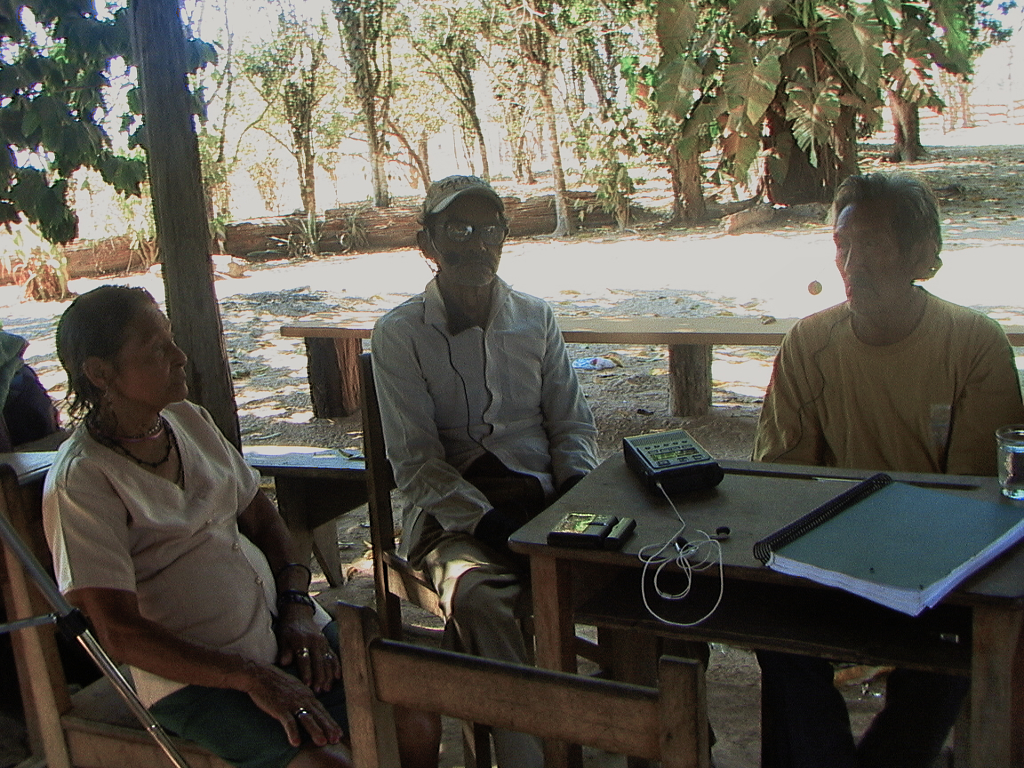
All that remains of Puruborá ritual practices and shamanic knowledge is in the memory of the elders, as the ethnographic and historical records made in the last hundred years - since contact - are totally silent on the matter.
It is known that, in Puruborá shamanism, the ‘pajés’ - which is today what they call a specialist in the art of healing - would inhale crushed angico seeds mixed with tobacco with the help of an assistant who would blow a short taboca. The use of angico powder places Puruborá shamanism next to the shamanic traditions of other neighbouring societies in the Guaporé valley.
The elder Paulo Aporete Filho says that in his youth he was trained by his uncle (considered as a father, due to having been raised by him) to become a shaman. Thus, “to become a pajé, the initiate had to know at least five languages, if he didn’t, he couldn’t pass” (the group had been fighting with many other ethnic groups and it was important to understand their respective languages). Although the training was not completed, Sr. Paulo Aporete is nonetheless a guardian of various kinds of knowledge, and has knowledge of a large number of medicinal plants. However, he does not share much of his experience and knowledge, as it must be passed only from father to son.
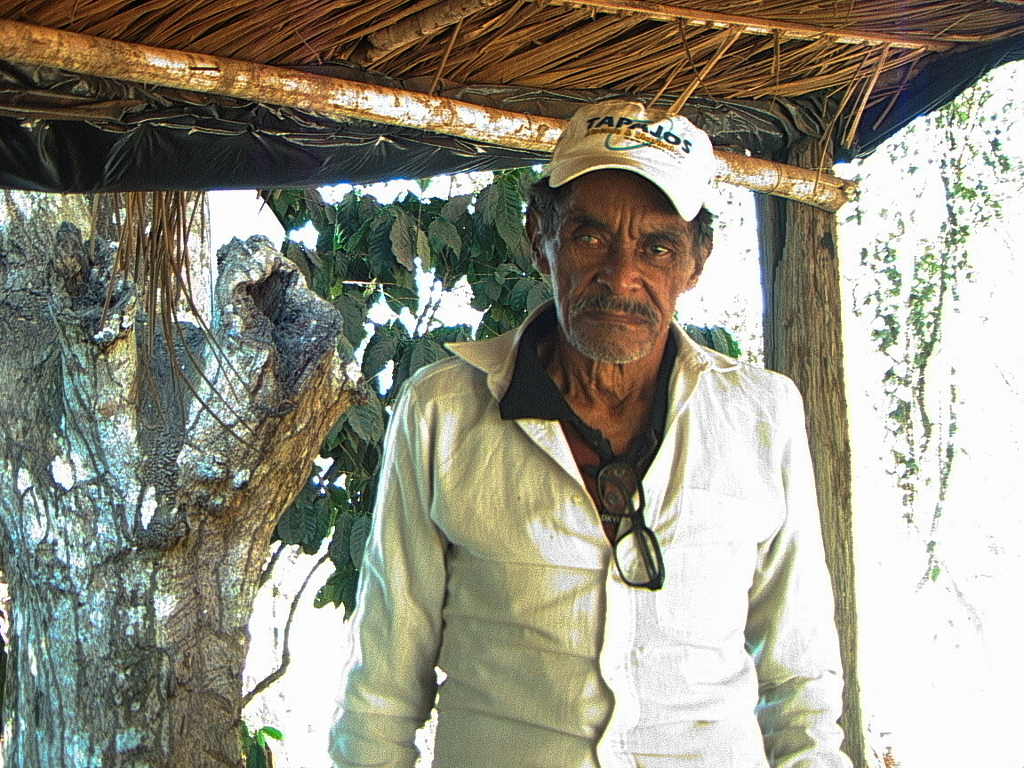
According to the Puruborá, when the shaman was younger, he was very fond of hunting. One day, people opened a ‘ barreiro ’ (a mud deposit with a large concentration of salt, which attracts animals) to hunt in the surroundings of the shaman’s house, and they came across a jaguar, which was the metamorphosed shaman. A Puruborá’s account goes some way to meet these conceptions: “the shaman is always ill, sometimes he is about to die, but suddenly he is well again. Any time he’ll be gone from there, he’ll die and become a jaguar.” According to the elders, all Puruborá, when they die, become jaguars. There is also an account of how, soon after D. Emília passing, a jaguar appeared in one of the village yards; some believed it was her, given that this jaguar in particular was very tame.
According to reports, before contact with the whites, the Puruborá buried their dead and set fire to the grave for a few days. After about four months, they would dig and remove the bones. The bones were then placed in clay pots and buried again in the same hole. In the words of Sr. Paulo Aporete Filho: “even today, in those places where many indians worked there are those clay pots appearing in the ground… today, where many cars pass by, the mouths of the pots appear, which is where they buried people.”
Puruborá warriors would take the head of their enemy with them, the ‘chief commander’; after being ‘scraped’ (cleaned), it was dried in the sun, painted white and stored. The decapitated head of the warrior symbolised the victory of the Puruborá, and showed the other ethnic groups “who the good warriors of history were”. They would use bows and arrows in combat and at times the Puruborá would use swords (bordunas) made of pupunha wood. Bows were also made of the same wood, and the string was made from embaúba wood; the arrow fletching was made from the feathers of birds such as the curassow, macaw and cujubim.
The Puruborá used to adorn themselves with body painting, even in everyday life. One person would be painted with up to three different types of paint, in black, blue, yellow and white. For each occasion, the Puruborá would paint themselves differently, but the graphics were drawn in jaguar and snake patterns: “they painted the person like a jaguar”. According to Puruborá mythology, a cobra entered the vagina of a woman, and thus the child was born with the image of the jaguar and the snake.
The ancient Puruborá ritual dances were described as follows: “they would form a circle, with a coivara at the centre, and would go dancing, circling and singing. They would all stamp their feet the same, the women went ahead, clinging to another woman’s arm, and the men would follow, or the other way round, the men in front and the women behind.” All this knowledge (among much else) is still kept in the memories of the elders, and has gradually been recovered by today’s Puruborá with their strategy of fighting for land and ethnic recognition.
Notes on Sources
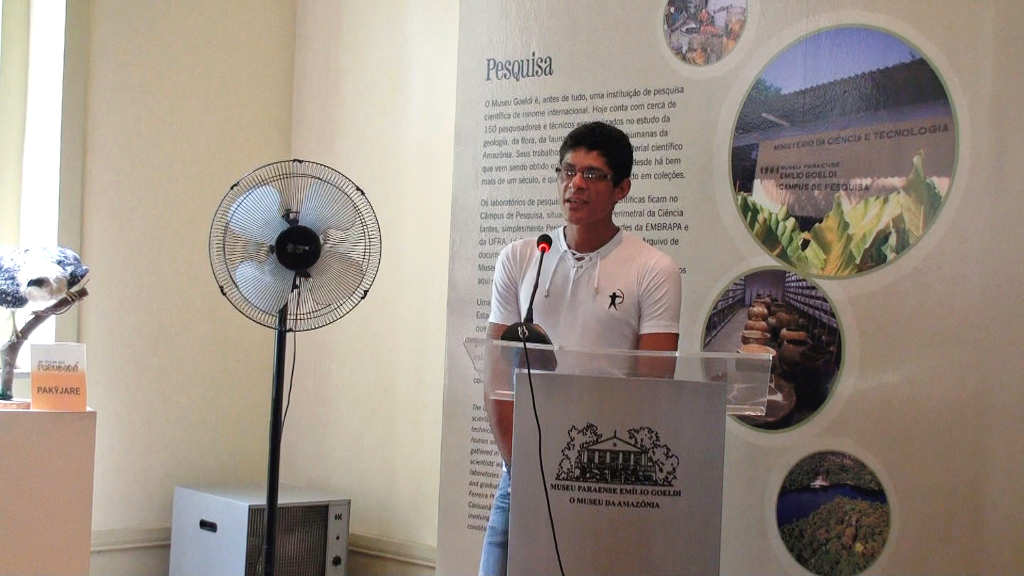
The bibliographical material available on the Puruborá is quite limited, and to date there is no in-depth research addressing the history, culture or current situation of this indigenous people in Rondonia. Historical references are sparse and succinct, mainly because Puruborá society seems to have been rapidly dismantled from contact and the moment following it, absorbed by working on the rubber plantation run by José Félix do Nascimento. With the closure of the rubber plantation in 1949, the Puruborá, scattered throughout the valley of the Guaporé river and its tributaries, practically disappear from the literature, until the resumption of their political claims at the start of the 21st century.
The first information about the Puruborá appears in unpublished documents written by Rondon in the 1920s, which are archived at the Museu do Índio, in Rio de Janeiro. Ana Vilacy Galucio, in her article Puruborá: notas etnográficas e linguísticas recentes (published in the Museu Paraense Emílio Goeldi – Bulletin - Human Sciences Series, in 2005) collected most of the oldest sources which provide sparse information regarding the Puruborá; most of the data of interest, in this material, are the lists of words in the indigenous language, with very little information of historical or ethnographic nature.
Olympio da Fonseca Filho, an epidemiologist linked to the Escola de Manguinhos, left a brief study (pages 195-204 of the book Estudos de pré-história geral e brasileira) about an endemic dermatosis among the Puruborá (called “ chimberê ”, according to his spelling, in the indigenous language), which he observed in loco in 1924. The group was at this time still located at the headwaters of the São Miguel River, and had very little contact with the non-indigenous population. Fonseca Filho's text also has the oldest known photographs of Puruborá individuals - three people affected by skin disease - taken, it seems, in 1924, three years after the group’s first contacts, which would have occurred in 1921.
The German anthropologist Emil-Heirich Snethlage, travelling through the Guaporé valley in the 1930s, left previous information about the indigenous peoples of the region. He was not exactly among the Puruborá, but found some scattered individuals, having taken photographs and compiled a list of words. Snethlage reports that the Puruborá, in 1934, lived on the Manuel Correia River, a tributary of the São Miguel River. Snethlage’s research journal in Brazil, with its extremely rich ethnographic data, remains unpublished, but is expected to be published in German in 2015. There are no plans for a Portuguese edition.
News of the ‘reemergence’ of the Puruborá arrived in 2001, and with it the first contemporary linguistic and anthropological studies, although it should be stressed that very little has yet been produced on this people. In 2005, Ruth Monserrat provides, in a book chapter, the first information on what remains of the Puruborá language. Since this same year (2001), linguist Ana Vilacy Galucio, from the Emílio Goeldi Museum of Pará (MPEG) has been working with the Puruborá, collecting extensive linguistic material, as well as narratives on the group’s history and culture. Galucio has also pioneered the gathering of bibliographic information regarding the Puruborá, and the results of her involvement with the group can be seen in her publications. Together with two still living elders - Sr. Paulo Aporete Filho (in Costa Marques) and Sr. José Evangelista (Seu Nilo, resident of Guajará-Mirim – the linguist organised the Vocabulário ilustrado – animais na língua Puruborá, published in 2013 by the Goeldi Museum, and which has been used as a tool for the recovery of the language, especially through its use as teaching material to support literacy at the Ywará Indigenous School.
The Relatório Final – Estudo do Componente Indígena – BR-429 assessment carried out by the National Department of Transportation Infrastructure (DNIT) to evaluate the impact caused by the paving of the BR-429 federal highway on the region’s indigenous societies contains relevant information on the Puruborá in 2008 (the year the technical group in charge of the study made their visit) in pages 225 to 233.
José Joaci Barboza, at the Ji-Paraná campus of the Federal University of Rondônia, has produced, together with his students, a series of explorations of various aspects of Puruborá history and culture (gender relations, education, narratives, political mobilization) since 2011, as part of the project Rescuing the Memory and History of the Puruborá People. The first major work by this group appeared in 2015, with a Master’s dissertation in psychology by Anatália Daiane de Oliveira (Escolarização indígena e identidade Puruborá: contribuições da escola para um povo ressurgido/resistente na Amazônia), defended at the Federal University of Rondonia and focused on the activities of the Ywará Puruborá State Indigenous Primary School. The article, by Anatália Daiane de Oliveira and José Joaci Barbosa, published in the electronic journal P@rtes (issue 15, December 2014), contains an inventory of these works, which have been presented at various congresses, mostly in Rondonia. Issue 27 of the Tellus journal (under the section ‘Indigenous Writing’) contains an article by Gisele Montanha (co-authored by Barboza and Daiane de Oliveira), a teacher at the Puruborá Indigenous School, in which she reflects on the ‘traditional myths’ of this people from the perspective of the effort for ethnic recognition. It is important to note that Gisele Montanha is the daughter of Hozana Puruborá, and has been responsible, together with other young Puruborá, for researching (and publishing) the history and traditional knowledge of her people.
More recently, Tarsila Menezes is preparing a Master’s dissertation on the relationships between Puruborá women and the plants from their yards and fields. More updated information (2015) can be found in the Panewa Especial volume, published by the Regional Indigenist Missionary Council (CIMI), of Rondonia, pages 117-118.
Sources of information
- BARBOZA, José Joaci. “Puruborá: narrativas de um povo ressurgido na Amazônia”. Manuscrito não publicado, 2012.
- CATHEU, Gil de. “Puruborá: mais um povo ressurgido em Rondônia”. Porantim, ano 23, no. 241, 2001.
- CIMI – RO. Panewa especial. Porto Velho: CIMI-RO, 2015.
- FILHO, Olympio da Fonseca. “Parasitismo e migrações humanas pré-históricas: contribuições da parasitologia para o conhecimento das origens do homem americano”. In: INSTITUO DE PRÉ-HISTÓRIA DA USP (org.), Estudos de pré-história geral e brasileira. Instituto de Pré-História/USP, 1969, pp. 1-346.
- GALUCIO, Ana Vilacy. “Puruborá: notas etnográficas e linguísticas recentes”. Boletim do Museu Paraense Emílio Goeldi – Série Ciências Humanas, vol. 1, no. 2, pp. 159-192, 2005.
- GALUCIO, Ana Vilacy; APORETE FILHO, Paulo & PURUBORÁ, José Evangelista. Vocabulário ilustrado – animais na língua Puruborá. Belém: MPEG, 2013.
- GALUCIO, Ana Vilacy. “Proposta de Ortografia para a Língua Puruborá – Tupi”. Belém, 2007. (Manuscrito não publicado).
- GALUCIO, Ana Vilacy & GABAS JR., Nilson. “Evidências de agrupamento genético Karo-Puruborá, tronco Tupi”. Trabalho apresentado no XVII Encontro Nacional da Associação Nacional de Pós-graduação e Pesquisa em Letras e Linguística, Gramado, 2002.
- GALUCIO, Ana Vilacy & GABAS JR., Nilson. “Revisiting the hypothesis of a Ramarama-Purubora branch of the Tupian family”. Trabalho apresentado no simpósio Amazônicas V, Belém, 2014.
- KOCH-GRÜMBERG, Theodor. “Wörterlisten “Tupí”, Maué und Puruborá”. Journal de la Societé des Américanistes, XXIII, 1932.
- LEONEL Jr., Mauro. Etnodicéia Uruéu-Au-Au. São Paulo: Edusp/IAMA/Fapesp, 1995.
- MONTANHA, Gisele; BARBOZA, José Joaci & OLIVEIRA, Anatália. “Puruborá: mitos de um povo indígena ressurgido na Amazônia”. Tellus, 14 (27), pp. 1510-174, 2014.
- MONSERRAT, Ruth Maria. “Notícia sobre a língua Puruborá”. In: A. Dall’Igna Rodrigues & A. S. A. Câmara Cabral (orgs.), Novos estudos sobre línguas indígenas. Brasília: Editora UnB, 2005.
- NATUREZA CONSULTORIA. Relatório Final – estudo de componente indígena – BR-429 (Estudos de Impacto dos Povos Indígenas ao Longo da BR-429, Trecho Alvorada d’Oeste – Costa Marques/RO). Porto Velho: Natureza Consultoria/DNIT/Riomar/Unir/Ministério dos Transportes, 2008 (inédito).
- NOGUEIRA, Bianca Coelho. Informações sobre Terras Indígenas e reivindicações fundiárias no estado de Rondônia (RO) e noroeste do estado do Mato Grosso (MT). Brasília: FUNAI, Informação Técnica no. 62, 2012.
- NOLETO, Juliana. “Análise preliminar do Relatório de Fundamentação Antropológica para a identificação de terras reivindicadas pelos índios Puruborá”. Brasília: FUNAI, 2008.
- OLIVEIRA, Anatália Daiane de. Escolarização indígena e identidade Puruborá: contribuições da escola para um povo ressurgido/resistente na Amazônia. Porto Velho: Unir, dissertação de mestrado em Psicologia, 2015 (inédito).
- OLIVEIRA, Anatália Daiane de; BRITO, Claudineia & BARBOZA, José Joaci. “Puruborá: indígenas ressurgidos e a construção da identidade”. P@rtes, 15, 2014 (Disponível em http://www.partes.com.br/2014/06/23/purubora-indigenas-ressurgidos-e-a-construcao-da-identidade/#.Val6jflViko, acesso em 17/07/2015).
- OLIVEIRA, Anatália Daiane de & BARBOZA, José Joaci. “Seminário de Educação (SED): levantamento dos trabalhos da temática indígena e inventário das produções acerca do povo Puruborá (2008-2013)”. P@rtes, 15, 2014 (Disponível em http://www.partes.com.br/2014/12/06/seminario-de-educacao-sed-levantamento-dos-trabalhos-da-tematica-indigena-e-inventario-das-producoes-acerca-do-povo-purubora-2008-2013/#.Val7P_lViko, acesso em 17/07/2015).
- REY, Dom François Xavier. Journal de Dom François Xavier Rey, Eveque de Guajará-Mirim – Rondoni – Brésil. Livre I: Du 9 de avril de 1929 au 29 janvier 1935 9Dernier móis em France et premier séjour au Brésil). Diocese de Guajará-Mirim (manuscrito).
- RIBEIRO, Darcy. “Indigenous cultures and languages of Brazil”. In: T. Stoddard (ed.), Indians of Brazil in the Twentieth Century. Washington: Institute for Cross-Cultural Research, pp. 77-166, 1967.
- _____. Os índios e a civilização: a integração das populações indígenas no Brasil moderno. São Paulo: Companhia das Letras, 1996[1970].
- RODRIGUES, Aryon Dall’Igna. “Relações internas na família linguística Tupi-Guarani”. Revista de Antropologia, 27/28, pp. 33-53, 1984/85.
- _____. Línguas indígenas brasileiras. São Paulo: Loyola, 1986.
- _____. “As línguas ‘impuras’ da família Tupí-Guaraní”. Revista Brasileira de Linguística Antropológica, 3(2), pp. 153-165, 2011.
- SANTOS, Elizabeth Silva & GALUCIO, Ana Vilacy. “Análise acústica dos segmentos implosivos da língua Puruborá”. Trabalho apresentado no III Seminário Internacional de Fonologia, Porto Alegre, PUCRS, 2007.
- SILVA, Ruth Henrique. Relatório de fundamentação antropológica para a identificação de terras reivindicadas pelos índios Puruborá. Brasília: FUNAI, 2008.
- SNETHLAGE, Emil-Heirich. Die Guaporé/Itenes Expedition (1933-1935): ein Forschungstabebuch. Rotger Snethlage, Alhard Snethlage & Gleice Mere (organizadores). Vienna: Böhlau, 2015 (no prelo).
- _____. Atiko Y: Meine Erlebnisse bei den Indianern des Guaporé. Berlin: Klinkhardt & Biermann Verlag, 1937.
- VANDER VELDEN, Felipe. “O retorno das onças: os Puruborá e os desdobramentos recentes da diversidade étnica e cultural em Rondônia”. Trabalho apresentado no IV Encontro internacional sobre Línguas e Culturas Tupí, Ji-Paraná/RO, 2013.